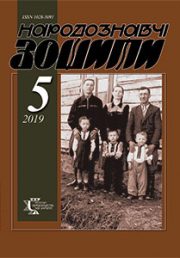The Ethnology Notebooks. 2022. № 5 (167), 1121— 1132
UDK [398.332.416:398.4:393](=161.2):642.732.24
DOI https://doi.org/10.15407/nz2022.05.1121
SEREBRYAKOVA Olena
- ORCID ID: https://orcid.org/0000-0002-1039-2920
- Candidate of Historical Sciences (= Ph.D. in history),
- Research worker at the department of the Modern Ethnology
- of the Ethnology Institute
- of National Academy of Sciences of Ukraine,
- 15, Svobody Avenue, 79000, Lviv, Ukraine,
- Contacts: e-mail: o-sereb@ukr.net
Abstract. The aim of the offered article is coverage of the layer of customs and rituals and worldview phenomena associated with the divination about the death with spoons; introduction into scientific circulation and analysis of new information about traditional memorial motifs in the mantic customs of Ukrainians during the period of holidays from Christmas to Epiphany.
The object of the research is the traditional world view and the custom and rite culture of the inhabitants of Ukraine, and the subject — the mantic ritual actions with spoons, which carried out during the period of holidays from Christmas to Epip hany. In addition to local beliefs, signs, customary prescriptions, ritual taboos related to predicting life expectancy, predicting the harvest, etc. are characterized.
The basis for the article are the materials of the field research, local history essays and works of the middle of the nineteenth and the beginning of the twenty-first centuries.
The methodology of this work is based on general scientific methodological principles and the basic requirements that apply to the works of historical and ethnological direction. The author uses various methods (field observation, comparative-historical, comparative, reconstructive, structural-semantic).
The analysis of ritual actions with spoons testified to the clear preservation of the manistic basis of the period of holidays from Christmas to Epiphany. The results of fortune-telling were made based on various notable signs: turning over, rustling, knocking, the arrival of a fly, traces on flour, etc. Divinations were carried out in various places, in particular, mythologically marked ones.
Keywords: mantic actions/practices (divination), Ukrainians, spoons, life, death, ritual nutrition, soul, ancestry.
Received 19.09.2022
REFERENCES
- Kutel’makh, K.M. (2001). Journey through the ages (Ancient elements in winter ritualism). Starosambirschyna. Al’manakh (Issue 1, pp. 87—96). Lviv: Misioner [in Ukrainian].
- Archive of the Institute of Ethnology of the National Academy of Sciences of Ukraine (then —Archive of the IN NANU). F. 1. Op. 2. Od. save 533 [in Ukrainian].
- Archive of Ivan Franko Lviv National University. F. 119. Op. 17. Od. save 719-E [in Ukrainian].
- Skrypnyk, H. (Ed.). Ethnographic image of modern Ukraine. Corps of expeditionary folklore and ethnographic materials. Funeral and memorial customs and rites, Calendar rituals (Vol. 5, 6). NAN Ukrainy; IMFE named after M.T. Rylsky. Kyiv [in Ukrainian].
- Archive of the IN NANU. F. 1. Op. 2. Od. save 704 [in Ukrainian].
- Roman, S. (2012). Christmas Eve rituals of Ukrainians of Zhydachiv region (based on ethnographic expedition materials). The Ethnology notebooks, 1 (103), 143—149 [in Ukrainian].
- Kopernicki, I. (1887). The sketch to the ethnography of the Ruthenians in Volyn from the materials collected by mrs. Zofija Rokossowska in the village Yurkivshchyzna. Zbior wiadomosci do antropologii krajowej (Vol. 11, pp. 130—228) [in Polish].
- Archive of the IN NANU. F. 1. Op. 2. Od. save 608 [in Ukrainian].
- Archive of the IN NANU. F. 1. Op. 2. Od. save 587 [in Ukrainian].
- Archive of the IN NANU. F. 1. Op. 2. Od. save 594 [in Ukrainian].
- Archival scientific reserves of manuscripts and phonorecor dings of the Institute of Art History, Folklore and Ethnology named after M.T. Rylsky of the National Academy of Sciences of Ukraine (then — ANFRF IMFE of the NASU). F. 14—5. Od. save 557 [in Ukrainian].
- Halajchuk, V. (2019). Popular calendar of Bereznivshchyna in rituals, customs and folklore. The Ethnology notebooks, 4 (148), 951—1000. DOI https://doi.org/10.15407/nz2019.04.951 [in Ukrainian].
- Halajchuk, V. (2019). Popular calendar of Slavutchyna in rituals, customs and folklore. The Ethnology notebooks, 5 (149), 1134—1164. DOI https://doi.org/10.15407/nz2019.05.1134 [in Ukrainian].
- Halajchuk, V., & Tsypyshev, S. (2020). Popular calendar in rituals, customs and folklore of Liubeshiv district. The Ethnology notebooks, 6 (156), 1454—1483. DOI https://doi.org/10.15407/nz2020.06.1454 [in Ukrainian].
- Halajchuk, V. (2015). Traditional calendar and household rituality of historical and ethnographic Volhynia (based on field materials from Goshchan district of Rivne region). Visnyk of the Lviv University. The series is historical (Issue 51, pp. 412—462) [in Ukrainian].
- Kurochkin, O.V. (1994). Ritualism (Calendar holidays and ceremonies). Podillya: Historical and ethnographic research (Pp. 358—384). Kyiv: Dolia [in Ukrainian].
- Chubinskij, P.P. (1872). Folk diary. Proceedings of the ethnographic-statistical expedition to the Western Russian region, equipped by the Imperial Russian Geographical Society: materials and research collected by P.P. Chubinsky (Vol. 3). Sankt-Peterburg [in Russian].
- Nowosielski, A. (1857). Ukrainian people (Vol. 2). Wilno: Naklad i druk T. Glucksberga [in Polish].
- Dykarev, M., & Lukych, V. (1895). Christmas holidays. Zoria, 4, 75—76 [in Ukrainian].
- Dykarev, M. (1905). Popular calendar of Valuy district (Borysiv volost) in Voronezh region. Materialy do ukrains’ko-rus’koi etnol’ogii (Vol. VI, pp. 113—204). Lviv [in Ukrainian].
- Halajchuk, V. (2012—2013). The folk calendar of the Zarichnenshchyna region in rites, customs and folklore. Scienti fic notebooks of the Faculty of History of Lviv University (Issue 13—14, pp. 43—83) [in Ukrainian].
- Vynohradova, L.N. (1981). Maiden’s fortune-telling about marriage in the cycle of the Slavic calendar rituals (West-East Slavic parallels). Slavianskyj y balkanskyj fol’klor. Obriad. Tekst (Pp. 13—43). Moskva: Nauka [in Russian].
- Shmajda, M. (1992). And I congratulate you. Calendar ritualism of the Ruthenians-Ukrainians of Czecho-Slovakia (Vol. 1). Bratislava; Priashiv: Slovats’ke pedahohichne vydavnytstvo; Viddil ukrains’koi literatury [in Ukrainian].
- Archive of Ivan Franko Lviv National University. F. 119. Op. 17. Od. save 317-E [in Ukrainian].
- Halajchuk, V. (2006). Mythological ideas about plants. Ethnogenesis and ethnic history of the people of the Ukrainian Carpathians: in 4 vol. (Vol. 2, pp. 590—608). Lviv: Instytut narodoznavstva NAN Ukrainy [in Ukrainian].
- Kolessa, F. (1898). Folk beliefs in Pidhirya, in the village of Khodovychy, Stryi County. Etnohrafichnyj zbirnyk (Vol. V, pp. 76—98). Lviv: drukarnia naukovoho tovarystva imeni Shevchenka [in Ukrainian].
- Halajchuk, V. (2009). Christmas and Epiphany cycle celebrations around Kremenets. Visnyk of Lviv University. The series is historical (Issue 44, pp. 215—240) [in Ukrainian].
- Levkovych, I. (1956). Ukrainian folk Christmas customs. London: Nakl. Ukrains’koi vyd. spilky [in Ukrainian].
- Hlushko, M. (2016). The Christmas Eve traditional customs and rites of the Ukrainians of Nadsiannia. The Ethnology notebooks, 6 (132), 1320—1330 [in Ukrainian].
- Archive of Ivan Franko Lviv National University. F. 119. Op. 17. Od. save 715-E [in Ukrainian].
- Archive of the IN NANU. F. 1. Op. 2. Od. save 213 [in Ukrainian].
- Schnajder, J. (1907). The people of Pecheneghin. Lud, I (Part II, vol. XIII, pp. 21—33). Lwow [in Polish].
- Shukhevych, V.O. (1999). Hutsul region. Chetverta chastyna. Druhe vydannia. Verkhovyna: Hutsul’schyna [in Ukrainian].
- Schnaider, J. (1899). From the land of the Hutsuls (Hutsul calendar). Lud, III (Vol. V, pp. 207—220). Lwow [in Polish].
- Schnajder, J. (1912). From the life of the highlanders, who live above the river Limnytsia. Lud, I—IV (Vol. XVIII, pp. 141—217). Lwow [in Polish].
- Hertsij, P. (1930). Beliefs on the Holy evening in Khust. Podkarpatska Rus’ (Part 1—2, pp. 27—30). Uzhhorod [in Ukrainian].
- Mushynka, M. (1988). Spiritual culture. Lemkivschyna: Zemlia — liudy — istoriia — kul’tura. N’iu-Jork; Paryzh; Sydnej; Toronto (Vol. II, pp. 292—407).
- Buhera, I. (1939). Customs and beliefs of Lemkivshchyna, 15. Lviv: Nash Lemko [in Ukrainian].
- Vasilechko, L. (1994). Palm Sunday. Folk customs, ceremonies and beliefs. Broshniv: Talia [in Ukrainian].
- Halajchuk, V. (2010). Traditional calendar customs and rites of the Old Sambir region. Notes of the Shevchenko Scientific Society (Vol. CCLIX, pp. 138—179) [in Ukrainian].
- Zoshak, M. (1937). Holy Evening and folk beliefs. Nash Lemko, 1 (73), 10 [in Ukrainian].
- Toporkov, A.L., & Tolstoj, N.I. (Ed.). Spoon. (2004). Slavic Antiquities: Ethnolinguistic Dictionary: in 5 vol. (Vol. 3, pp. 129—134). Moskva: Mezhdunarodnye otnoshenija [in Russian].
- Archive of the IN NANU. F. 1. Op. 2. Od. save 281 [in Ukrainian].
- Reinfuss, R. (1990). In the footsteps of Lemkos. Warszawa: Wyd-wo PTTK; Kraj [in Polish].
- Waigel, L. (1877). Sketch of the city of Kolomyia. Kolomyja: Drukiem H. Zadembskiego i spоlki [in Polish].
- Ivanov, P. (1907). Life and beliefs of the peasants of the Kupyansk district, Kharkiv province. Sbornik Har’kovskogo istoriko-filologicheskogo obshhestva (Vol. 17). Kharkov: Pechatnoye Delo [in Russian].
- ANFRF IMFE of the NASU. F. 14—3. Od. save 96 [in Ukrainian].
- Archive of the IN NANU. F. 1. Op. 2. Od. save 212 [in Ukrainian].
- Archive of the IN NANU. F. 1. Op. 2. Od. save 588 [in Ukrainian].
- Silets’kyj, R. (2011). Traditional building rites of Ukrainians. Lviv: LNU imeni Ivana Franka [in Ukrainian].







